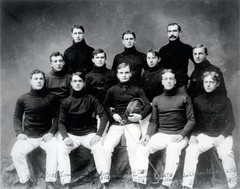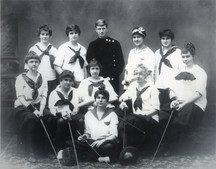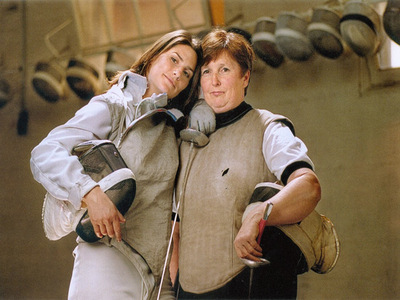The History of Stanford Fencing

Men's Fencing Team, Stanford, 1890s
Fencing at Stanford has a history as old as the university itself. Started in 1891, the year of the university's founding, fencing was one of the core sports of the original athletic program. Fencing was confirmed as an international sport by its inclusion in the first modern Olympic games in 1896.



Women's Fencing and the Co-Ed Programs Over the Years
1891-1929: Beginnings of the Fencing Program
The Stanford Fencing Club was one of the first organizations created at Stanford. Renaissance man Harry Wilfred Maloney began the fencing program at the Woodpecker Lodge on the Stanford campus in 1891, and continued to coach well into the twentieth century. The first men's gymnasium constructed in 1905 included a room dedicated to the sport. Maloney coached not only fencing, but five other sports as well. By 1902, fencing was known as the club Foil and Mask. It was offcially adopted as a "Minor Sport"in 1916, and the team began to win trophies the following year. Maloney and his foil team of five--Phil Davis, Rex Hamaker, L.R. Skelton, P.F. Brown, and R.O. Bullis would beat Cal repeatedly in the early years (1917 Quad).

1929-1964: Fencing Becomes a Major Sport
In 1929, Stanford-alumnus Elwynn B. Bugge returned to the university as a teacher-coach of tennis, a fencing master, administrator, and teacher of sports administrative practice until his retirement in 1964. The original Stanford Fencing Association used his name to recognize outstanding fencers with the Elwyn Bugge Fencing Award.
In 1932, the women's gym at Roble opened, providing space for women fencers. Both men and women fencers used Roble from 1936 until 2005, with the exception of the years during the Second World War when Roble was converted into a temporary infirmary.
In the 1950s, Hungarian George Domolky (pictured left) left the University of Budapest following political unrest, and came to Stanford where he continued to fence sabre, helping them to a winning season in 1958. He participated in the 1958 US National Sabre Team Championship and Finalist in Sabre Individuals, and placed number four in the finals for the 1959 US Nationals Sabre Individuals.
Above: Olympic Champion George Domolky

1964-82: Coach Jean Helliwell
Jean Perhem Helliwell, '47, and member of the Stanford Fencing team between 1940 and 1942, joined Stanford Fencing as the Senior Cardinal Varsity fencing coach in 1964. She was the first woman to be a fencing coach at Stanford, and also the first to coach for both the men's and women's teams. Long recognized as one of the leading fencing authorities on the west coast, she was also an academic advisor for over thirteen years. Her co-ed coaching paved the way for the merging of Stanford's men's and women's athletic programs between 1974 and 1975. In 1982, she retired after 18 years of service. She served on the NCAA Women's Fencing Committee, was the former president and secretary of the Northern California Intercollegiate Fencing Association, and president and vice-president of the Western Intercollegiate Fencing Conference. She passed away on May 1st, 2001.
Right: Jean Helliwell, Fencing Coach of 18 Years

1980-2005: Coach Sherry Posthumus
Sherry Posthumus came to Stanford as an individual coach for athlete Jennifer Yu, and went on to become one of the most influential coaches of the twentieth century. Sherry represented the United States as the team leader of three Olympic Teams (1988, 1992, 1996), as well as managing the Senior and Junior World Championship and Pan-American teams. She was the first woman to become an Olympic team leader in the history of the fencing, and was also a member of the US Olympic Committee. She helped shape the growth and development of the sport on an international scale.
Sherry coached at Stanford University for twenty-five years. During that time she built a highly competitive collegiate program and became Assistant Athletic Director. Her students included her daughters Lisa and Jennifer, and future USFA Champion and Hall of Fame Member Nick Bravin. She was named NCAA Women's Coach of the Year and chaired the NCAA National Fencing Committee. While at Stanford, Sherry began the enormously popular Pirate Camp that continues today, turning Stanford campus into a haven for young swashbucklers each summer. Sherry Posthumus left a trail of new fencing clubs like footprints in her wake throughout her adult life, especially as founder of the Stanford Fencing Club, co-founder of San Jose Fencing Center and founder of The Fencing Post. She served the USFA as a member of the Coaches and Junior Development Committees and eventually, as a Vice President.
A consummate hostess, cook, tinkerer, entrepreneur and wit, she is remembered as a beloved wife, mother, friend, coach and advisor by all who had the pleasure of knowing her. Sherry was inducted into the USFA Fencing Hall of Fame July 7, 2009.

1995-Present
Stanford Fencing entered its second century of existence as one of the university's top athletic programs. Under Olympic coach Zoran Tulum and later former-Olympian George Pogosov, the fencing program has consistently placed within the top 10 programs in the country. In 2005, Stanford fencing was moved from its long-time home in Roble Gym to a new facility in the Arrillaga Family Recreation Center, complete with ten fencing strips, lockers, an equipment room and several offices. Current Head Coach Lisa Posthumus Milgram, daughter of Sherry Posthumus, was unanimously voted Coach of the Year in 2009. She and the other coaches continue to lead the team into the second decade of the 21st century.
Left: 2009 Coach of the Year Lisa Milgram. Below: Current Coach and Former Olympian George Pogosov
